Posted by Elena del Valle on August 8, 2012
An Audience Worth Reaching
By Nhora Barrera, president, TMNcorp
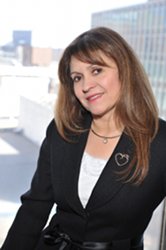
Nhora Barrera, president and CEO, TMNcorp
Photo: TMNcorp
There’s no question that America’s population is getting older, and it’s happening fast. Nearly 11,000 Americans turn 65 everyday 1. This aging population, however, isn’t homogenous. It is a demographic that reflects the nation’s growing diversity and challenges us to rethink how we reach them with information that will benefit their quality of life and health.
Hispanics seniors are a perfect example of this challenge. In 2008, there were 2.8 million Hispanics over 65 in America. But in just seven years, the group is predicted to be America’s largest elderly ethnic group.2 This number will only increase as the number of Hispanic-Americans continues to grow.
Read the complete article at Hispanic Seniors: An Audience Worth Reaching
Posted by Elena del Valle on August 6, 2012
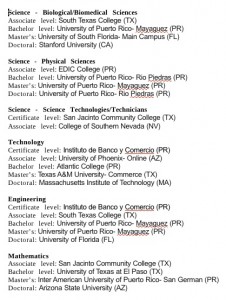
Top institutions awarding certificates/degrees to Latinos in STEM 2009 to 2010 by academic level – click to enlarge
Latinos earned only few (8 percent) certificates and degrees in Science, Technology, Engineering, and Mathematics (STEM) mostly from 25 institutions of higher learning, according to a recent Excelencia in Education report released last week. Excelencia, a nonprofit organization, strives to accelerate higher education success for Latino students.
“This analysis is straightforward: we know where Latinos are earning their degrees in STEM and we know what some of these institutions are doing, with intentionality, to improve Latino success in STEM fields,” said Deborah Santiago, author of the report and co-founder, Excelencia in Education. “What we need to determine now is whether more institutions and more employers will seize the opportunity to educate and employ more Latinos in professional STEM fields.”
In 2011, Latinos in the STEM workforce were more likely to be in lower paying service occupations such as electrical, electronics, and electromechanical assemblers, telecommunications line installers and repairers, and aircraft mechanics and service technicians rather than better paid professional occupations such architectural and engineering managers and computer and information systems managers.
Since the average age of Hispanics is lower than that of the general population and there is a high number of Latinos entering the workforce the findings are significant. The Executive Summary of the report indicates: “Given the relative youth of the Latino population relative to the aging of the u.s. population overall, supporting the increased growth of Latinos with postsecondary credentials in sTeM is critical to meeting the projected workforce needs of the nation by 2020.”
In 2009 to 2010, the top 25 institutions awarding undergraduate degrees or certificates to Latinos in STEM were in Texas, Florida, California, Arizona, Illinois, New Mexico and Puerto Rico. That same year, 60 percent of degrees conferred to Latinos in the science and related files were bachelor degrees, making those students most likely to enter service occupations in their chosen fields.
The 37-page report, Finding Your Workforce: The Top 25 Institutions Graduating Latinos in Science, Technology, Engineering, and Mathematics (STEM) by Academic Level (2009-10), was authored by Santiago, vice president for policy and research, and Megan Soliz, research assistant, Excelencia.
Posted by Elena del Valle on August 3, 2012
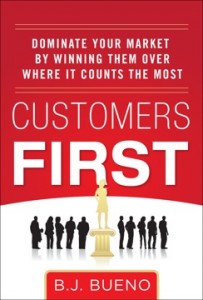
Customers First book cover
Photos: Newman Communications
What drives your customers? How do you create a brand that attracts loyal, profitable customers to your business? The correct answers to these questions could ensure the success of a company.
Bolivar J. “BJ” Bueno, founder and managing partner, The Cult Branding Company believes that most businesses struggle because they are not clear on the identity of their target customer; that they can’t rely on market research and focus groups for the answers because 90 percent of consumer behavior is unconscious; and that customers today are empowered, skeptical and educated consumers.
In Customers First: Dominate Your Market by Winning Them Over Where It Counts the Most (McGraw-Hill Professional, $26), his newly published 218-page hardcover book, he examines the strategic competitive advantage he believes comes from a complete, comprehensive understanding of a brand’s best customers. The book is divided into twelve chapters and four main parts, Introduction: Things Have Changed; Modeling Defined; Building Your Brand Model; and Deploying Your Model.

Bolivar J. Bueno, author, Customers First
Bueno says in the first chapter that there is no longer business as usual and that newcomers have to create a new normal. Customer awareness and loyalty, he explains in the next chapter, is what creates and expands a brand. Developing a great Brand Model, he says later in the book, requires time and adherence to that model. The author believes that effective predictions of consumer behavior helps make companies and their products or services dominant in the market.

Click to buy Customers First
Comments:
Filed Under: Books
Posted by Elena del Valle on August 1, 2012

New York International Latino Film Festival 2012 Serial Killer Movie Recipe ad – click to enlarge
Video, photos: Wing
Hoping to reach New York City Urbanites between the ages of 25 and 45 the 2012 HBO New York International Latino Film Festival (NYILFF) with the pro bono help of Wing, a marketing communications agency, launched a print and television ad campaign aimed at broadening the appeal of the NYILFF, running August 13-19, 2012 in New York City. Scroll down to watch a 30-second video ad for the 2012 campaign.
“The overall reach of the campaign has been far. We have been picked up by a great deal of pubs including Creativity, TrendHunter, Ihaveanidea.com, Latinspots, Ads of the World, among others,” said Marieugenia Cardenas, assistant account executive, Wing.

New York International Latino Film Festival 2012 Chick Flick Movie Recipe ad – click to enlarge
Thirteen people under the supervision of Tania Salter, vice president and head of Production at Wing, worked on the campaign this year producing six print ads and two television spots. Some ads ran as public service announcements and some as paid advertisements in theaters. To date ads have aired on NBC, Telemundo, and Clearview Cinemas.
The campaign, in English and Spanish, pokes fun at Hollywood cliches, relying on the tagline “Some movies are easy to make. Films are a different story.” The stereotypical Hollywood movie types the campaign makes fun of are: Sports Comeback, Serial Killer, Chick Flick, Buddy Cop and Alien Invasion themes.

New York International Latino Film Festival 2012 Sports Comeback Movie Recipe ad – click to enlarge
“We were trying to attract people who normally don’t go to this festival (who don’t necessarily speak Spanish) while at the same time not alienating the core audience (who does speak Spanish),” said Cardenas.
This is the second year the festival is partnering with Wing. Last year the campaign poked fun at Hollywood movies for casting Latinos only in roles like maids, gardeners, and fruit stand vendors (see With video NY Latino Film Festival ad campaign makes fun of Hollywood cliches).
According to promotional materials, the campaign went viral through earned media, becoming the top story on Trendhunter and Buzzfeed, and garnered 29 million impressions. Dating back to 1999, the NYILFF strives to showcase the work of emerging Latino filmmakers in the United States and Latin America.
Posted by Elena del Valle on July 27, 2012

Sam, Elida and Dulce Mejia-Perez outside of Quetzaltenango, Guatemala
Videlo, photos: POV, Theo Rigby, Katina Papson
In 2010, with a $10,000 budget and support from his graduate program, filmmaker Theo Rigby, with the help of three assistants, showcased the case of a family of five divided by the parents deportation from the United States many years after they entered the country illegally. Sin País (Without Country in Spanish), a 19-minute documentary style short film, follows the Mejia Family through the deportation process of the parents who leave the country with Dulce, their young daughter, while their two teenage children remained in the United States. Scroll down to watch a video clip in Spanish with English subtitles.
The film, a Student Academy Award winner, features tearful scenes in the family’s home in the United States, rural takes with the parents and their youngest child on their return to Guatemala, interviews with the two teenagers, and a Christmas visit from the teenage daughter from the United States to Guatemala; the teenage boy could not travel because his immigration status was uncertain.

Filmmaker Theo Rigby
“I made Sin País to show some of the nuances and complexities of deportations, and to address how mixed-status families often grow deep roots in the U.S. over many years,” said Rigby. “The film shows how deportations have vast ripple effects that often effect many U.S. Citizens, and as ICE deported a record number of people in 2011 (400,000), the story of Sin País resonates very deeply on myriad social and political levels today.”
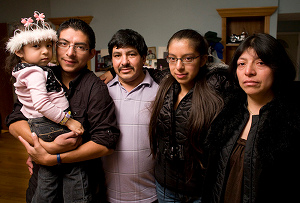
The Mejia-Perez family in California on the night of the deportation of Sam and Elida
The film was selected by Point of View (POV), a long running showcase that features the work of some of today’s independent documentary filmmakers, and will air on on television nationwide in POV Short Cuts Thursday, August 9, 2012 at 10 p.m. on PBS. The one-hour program, part of the 25 anniversary season of POV, will also include The Barber of Birmingham: Foot Soldier of the Civil Rights Movement and three new animated shorts: Eyes on the Stars, Facundo the Great and A Family Man.

Cynthia Lopez, co-executive producer, POV
“About 1,200 documentaries are submitted a year and we select anywhere between 12-18 premieres. In terms of shorts, about 100 shorts are submitted to POV per season and we select approximately 6-8 per year. Highly competitive,” said Cynthia Lopez, co-executive producer at POV by email when asked about the selection process.
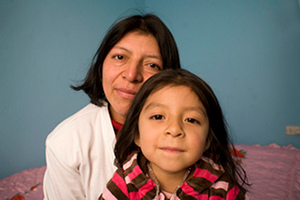
Elida and Dulce Mejia-Perez
Rigby’s work has focused on topics ranging from the war in Iraq to the justice system. For the past six years he has been making films about immigration issues in the United States. POV has brought 325 acclaimed documentaries to millions of viewers nationwide. POV Short Cuts will stream on the POV website from August 10 to September 9, 2012.
Posted by Elena del Valle on July 25, 2012

Fewer young people are obtaining a driver’s license, according to researchers at University of Michigan Transportation Research Institute
Photo: HispanicMPR.com
Research conducted by Michael Sivak and Brandon Schoettle of the University of Michigan Transportation Research Institute, Ann Arbor, Michigan indicates again that fewer young people, compared to previous decades, are obtaining a driver’s license. The researchers reviewed driver license and general population information from the Federal Highway Administration and the United States Census Bureau to find that the trend they had identified in the past continues. As an example, they point to drivers 19 years of age. Their findings indicate 87.3, 75.5, and 69.5 percent of these individuals had a driver’s license in 1983, 2008, and 2010 respectively.
“The most significant aspect of our findings is that the trend that we observed in a previous study is continuing,” said Sivak by email. “Specifically, young and middle-aged persons are less likely to get a driver’s license now than were the corresponding age groups 30 years ago. We think that the availability of electronic communication has a lot to do with this trend.”
Earlier this year (see Older adults more likely drivers than in past decades), after examining data for 1983 to 2008 in the United States and 14 other countries they concluded there was a noticeable decrease in the percent of young people obtaining a driver’s license and an increase in the percent of older people with one. They have since examined additional data in the United States through 2010 that indicates the trend continues for young people and that there is a reduction in the proportionate number of driver’s licenses across age groups.
They still believe the trend relates inversely to the continued increase in internet usage. They concluded that the more people rely on the internet for contact the less they require in person contact.
It’s unclear whether the trend applies to all market segments. Hispanics which as a market are younger than the general market may be affected. A Ford Motor Company representative when asked about the trend responded negatively.
“For Hispanic consumers cars are a symbol of freedom, accomplishment and status,” said Alvaro Cabal, manager, Multicultural Communication, Ford Motor Company.
Except in cities with efficient mass transportation systems like New York and Washington, D.C., the research findings are not in evidence in car buying behavior, he explained by phone. He went on to say that since the 2008 recession when car sales dropped the company has experienced a steady increase in car purchases, especially among 18 to 45 year old buyers.
Posted by Elena del Valle on July 23, 2012

Eduardo Caballero, co-owner, Caballero Spanish Media
Photo: BigVoice Communications
Entrepreneurs Eduardo Caballero and Peter Spengler of Coral Gables, Florida are owners of Caballero Spanish Media (CSM) founded in 1973. They plan, subject to regulatory and other approvals, to buy nine television stations in Texas and Central California targeting local Mexican-Americans, growing from two staff to eight or more depending on market conditions at the time of the purchase.
Following CSM’s acquisition, the local stations are expected to broadcast a new portfolio of original Spanish language content produced in Northern Mexico and the United States for the domestic Spanish dominant Mexican consumer, offering popular and traditional music formats and health programming.
“With the broadcast media landscape undergoing drastic changes and audiences becoming more fragmented, this is a great time to offer a rich variety of music and entertainment to a growing Hispanic market and better meet the needs and wants of our audience” said Eduardo Caballero, president, CSM.
“We believe that the concentration, and homogeneity of these areas (being made up almost entirely of Mexican-Americans) gives us the unique opportunity to serve this market separately from the rest of the Hispanic population of this country.”
The Texas stations are KGBS-CA in Austin and KGMM-CA in San Antonio. The California stations are KMMC-LD in San Francisco, KMMA-CD in San Luis Obispo, KZMM-CD in Fresno, KMUM-CA in Sacramento, KMMD-CD in Salinas/Monterey, KMMW-LD in Stockton, KQMM-CD in Santa Maria, and KVMM-CD in Santa Barbara to be operated by CSM under a Local Marketing Agreement.
Currently the stations reach an estimated 1.1 million Hispanic households in Central California and 600,000 in San Antonio and Austin. The buyers goal is to grow the audiences significantly in both markets.
Comments:
Filed Under: Media
Posted by Elena del Valle on July 20, 2012

Sirenas promo image
Photos: Discovery en Español
Earlier this year, Animal Planet aired Mermaids: The Body Found, a two-hour science fiction special narrated by Greg Stebner based on “real events and scientific theory” filmed in Cape Town, South Africa; London, England and Bristol, United Kingdom. The computer graphics were done in Winchester, United Kingdom.
Mermaids explores the so called Aquatic Ape Theory which brings forward the possibility of human like evolution underwater. The filmmakers wonder whether it is possible that while mankind evolved into terrestrial humans some, aquatic relatives they believe, could have evolved into beings similar to the mythical mermaid. Discovery en Español will air Sirenas, a Spanish language version of the program, Sunday, July 22 at 9 p.m. ET/PT and 7 p.m. ET/PT July 28.

Image from Sirenas – click to enlarge
The program points to differences between man and other primates and the many features they believe humans share with marine mammals such as webbing between fingers (other primates don’t have this, according to promotional materials), subcutaneous fat (providing insulation from cold water), control over breath (humans can hold their breath up to 20 minutes, longer than any other terrestrial animal, the program producers point out), limited body hair (lack of hair avoids drag in the water), instinctive ability to swim from birth, and a highly developed brain dependent on nutrients provided by seafood, according to the program’s promotional materials.

Image from Sirenas – click to enlarge
The producers focused on two facts in the special. First, a series of covert sonar tests conducted in the early 1990s by the United States Navy and linked to mass die-offs of whales, which washed up on various beaches throughout the world. They also gave weight to a mysterious sound deep in the Pacific thought to be organic detected (though never identified) in 1997 by scientists at the National Oceanic Atmospheric Administration (NOAA).
Mermaids was produced for Animal Planet, part of Discovery Communications, by Darlow Smithson with Tom Brisley as executive producer for Darlow Smithson; Charlie Foley as executive producer, creator and writer; Vaibhav Bhatt, co-writer and supervising producer, and Jamie Dugger, producer, for Animal Planet. Steve Gomez of Bandito Films was director of animation. Discovery en Espanol is the Spanish-language voice of Discovery.
Posted by Elena del Valle on July 18, 2012
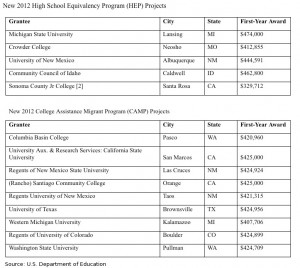
Click to enlarge
Photo, chart: U.S. Secretary of Education
Targeting migrant students and their families? You may be interested to know that the U.S. Department of Education awarded $5.9 million to 14 grantees in nine states for education for high school and college students migrant or seasonal farm workers, or the children of such workers. The five-year grants are awarded under the High School Equivalency Program (HEP) and the College Assistance Migrant Program (CAMP) through the Department’s Office of Migrant Education said to serve 5,000 HEP and 2,000 CAMP students annually.
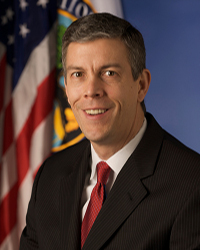
Arne Duncan, U.S. Secretary of Education
“The students helped by HEP and CAMP are some of the most motivated learners in America,” said Arne Duncan, United States Secretary of Education. “These grants will help hardworking farmworkers and their families obtain the quality education that they need to compete in the 21st century global economy.”
The purpose of the HEP grants is to help migrant and seasonal farmworkers, and members of their immediate families obtain general education diplomas that meet the guidelines for high school equivalency established by the state in which the HEP project is conducted. The program helps migrant youth gain employment or placement in an institution of higher education or other postsecondary education or training via counseling, job placement, health care and housing for residential students.
CAMP grants support students who are migratory or seasonal farm workers, or the children of such workers, during their first year of undergraduate studies and to continue in postsecondary education. The mission of the Office of Migrant Education (OME) is to “provide excellent leadership, technical assistance, and financial support to improve the educational opportunities and academic success of migrant children, youth, agricultural workers, fishers, and their families.”
Posted by Elena del Valle on July 16, 2012
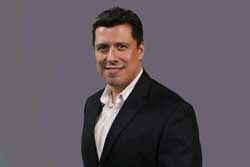
Albert J. Estrada, VP, business development, Olympusat

Oscar Madrid, director, Multicultural Marketing, Verizon
Photos: Olympusat, Verizon
A podcast interview with Albert J. Estrada, vice president, business development, Olympusat,Inc., and Oscar Madrid, director, Multicultural Marketing, Verizon, is available in the Podcast Section of Hispanic Marketing & Public Relations, HispanicMPR.com. During the podcast, they discuss marketing to Hispanics with Elena del Valle, host of the HispanicMPR.com podcast.
In the early 1990s, Albert started his career in the entertainment industry as account executive with Home Box Office (HBO) where we managed the west Texas region for HBO’s cable television affiliate sales group. Later he became part of the initial team that launched DirectTV. While there he led and crafted the marketing strategy for DirectTV’s introduction into fifteen countries within the Latin America region. After that he marketed and sold high-power geostationary satellites at Space Systems Loral.
Oscar, a native of El Paso, Texas, oversees the national marketing strategy for Hispanic, Asian and African American consumer segments for Verizon FiOS and other consumer products and services. He is a 23 year veteran of the telecom industry, beginning his career with Bell Atlantic, a Verizon legacy company, in 1989. Oscar has served as a board member for the Orange County Hispanic Chamber of Commerce Education Foundation, has partnered with the Hispanic Scholarship Fund on fundraising initiatives and supports Aspira New York’s fundraising and marketing efforts. He is a recipient of the New York Chapter of Aspira’s Latino Leaders Award.
To listen to the interview, scroll down until you see “Podcast” on the right hand side, then select “HMPR Albert Estrada, Oscar Madrid ” click on the play button below or download the MP3 file to your iPod or MP3 player to listen on the go, in your car or at home. To download it, click on the arrow of the recording you wish to copy and save it to disk. The podcast will remain listed in the July 2012 section of the podcast archive.































